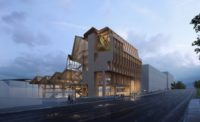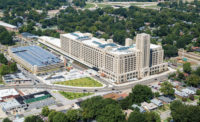EskewDumezRipple & WOLF ACKERMAN’s Center of Developing Entrepreneurs Steps Up to History
Charlottesville, Virginia

Charlottesville’s Center of Developing Entrepreneurs (CODE) is a beguiling chameleon, created to foster the growth of new local businesses while also engaging its community. Designed by the local firm WOLF ACKERMAN and the New Orleans–based EskewDumezRipple (EDR), which has a second office in Washington, D.C., the project was conceived by CSH Development to encourage nearby University of Virginia graduates to remain in the city. The goal: to transform it into a business hub that could compete with the likes of Silicon Valley and Austin, Texas. “The whole idea of the building was, utilizing the concept of a coworking space as an entry point for young people,” says EDR principal José Alvarez. This vision—to attract and nurture talent within a building—he says, inspired a form that steps from level to level to symbolize how one can move up and “grow” a business.

A hybrid stair/ramp navigates the site’s slope (top of page) and invites the public into a plaza (above) at the heart of the building complex. Photo © Alan Karchmer, click to enlarge.
Built on an incline, the structure changes scale at every elevation: On Main Street, the city’s historic pedestrian mall, it is a three-story building, in keeping with the small shops lining this promenade. On Water Street, at its southern edge, the building rises nine stories from the ground to its apex. And, from the top of Vinegar Hill, looking back toward the mall, it takes on another perspective with a four-story band of brick rainscreen, with staggered windows above a ground-level plinth, which grows from single- to double-height as the building moves downhill across an 18-foot change in elevation. It also masks the point where the building steps up, adding another three levels clad in clay-colored metal above the four-story brick band on its Water Street frontage.

1
The CODE structure steps up to nine stories on its south side (1) providing a series of landscaped terraces for occupants (2) at successive levels. Photos © Alan Karchmer

2
Topographically and sectionally complex, the building is straightforward in plan: A-shaped, with its taller side parallel to the street grid, its shorter side at a roughly 45-degree angle to it, and a two-story bridge connecting the two. (Work on the site also included a three-story party wall building at the end of the mall above the parking garage). The Center’s northeast corner faces the mall, with its lowest volume at the bottom of a hill (into which it is partially embedded) and seven levels of terraced green roofs stepping up behind it. Varied facade treatments disguise the full scale of the remaining structure. “Charlottesville is very cautious and approaches modernism with one eye looking sideways,” says Fred Wolf, principal of WOLF ACKERMAN. “When you’re trying to do something this large in the context of two- and three-story buildings that define the mall, there are many ways this could go wrong in terms of the scale differential.”
The project kept on track in part due to the client’s desire to give back to the community. The idea grew into a public plaza, between the building’s two wings, that flows from the pedestrian mall. This open space navigates the 11-foot grade change between the streets with hardscape, affectionately called the “stramp” for its integration of steps and accessibility ramps into the sloped terrain, leveling midway at a plateau populated with young trees, café seating, and benches. At the top of this outdoor respite, a triangular water feature nestles into an acute angle under the two-story bridge connecting the building’s north and south wings, with the mirrored underside of the bridge bouncing reflections throughout the plaza.
“Part of the success of the building and its urban gestures result from the client making that important. Rather than maximizing the development parcel, there was the foresight to understand that, in some cases, less is more,” says Wolf’s partner, Dave Ackerman. “Creating these kinds of public and private spaces, transforming the center of the mall, and giving it a sense of place wouldn’t have been possible if they weren’t on board.”
Health and well-being was another client driver for the 215,000-square-foot project. Interiors within the 50-foot-wide floor plates benefit from daylight, as well as natural ventilation from operable windows—which contribute to three and a half times the code-required fresh-air exchange—and attached green-roof terraces. These, among other sustainability incentives, led to an eventual LEED Platinum certification.
Programmatically, the building welcomes visitors into a public lobby with a coffee bar facing the mall. This transitions into coworking spaces, in a variety of configurations, deeper in the building and on its second floor. Amenities there range from a kitchen and conference room to showers, a podcast studio, and single-occupant work booths. The upper levels are all core-and-shell office spaces, ready for fit-out, each with its own roof terrace; the third floor is multi-tenant; the rest are intended for single companies. On the plaza’s east side, the project retains a mall-facing historic facade, with new-build infill containing retail spaces designed as short-term lease opportunities, for local vendors to test ideas in and build customer bases before expanding elsewhere.

3
The first two floors are occupied by shared coworking spaces (3 & 4), amenities like the outdoor fountain (5), and retail. Photos © Alan Karchmer

4

5
Multiple circulation routes facilitate chance encounters among members of the coworking spaces and office tenants, while the glazed base of the building displays the buzz of activity within for passersby. Where Water Street descends from the top of the hill, the plinth’s slope accommodates a 200-seat auditorium that can host events or expand the coworking area, its flexibility part of a future-proofing strategy. “The building is like a big mixing valve,” Wolf says, “providing an environment that allows for interaction and overlap—that sort of cross-pollination among people doing totally different things.”
With the pandemic’s causing a shift in thinking around workplace best practices, the CODE strategy for a healthy and lively working environment that will pull people in—and, it is hoped, retain them—seems to be paying off. The building is almost fully committed, if not yet occupied, despite its opening’s mid-pandemic timing. “This project proves the theory that a building with amenities makes it worth going back to work,” says EDR’s Alvarez. “It also creates community, so it’s worth coming here to exchange ideas, versus staying at home or working from anywhere.”
Today, the plaza and building have become embedded as part of the neighborhood, included as locations for the city’s Tom Tom Festival (short for Tomorrow Tomorrow), with its open-air events and Future Forward Conference. The Center of Developing Entrepreneurs provides Charlottesville’s already vibrant and walkable Main Street with a community anchor that pushes the city’s entrepreneurial spirit to new heights.
Click plan to enlarge

Click plans to enlarge

Click section to enlarge

Credits
Architect:
EskewDumezRipple — José Alvarez, Noah Marble, Steve Dumez, Z Smith, Tyler Guidroz, Jill Traylor, Max Katz, Shannon Griffin, Tom Gibbons, Alex Swiggum, Kelsey Wotila, project team; WOLF ACKERMAN — Fred Wolf, Dave Ackerman, Mark Merolla, Joey Laughlin, project team
Engineers:
Fox & Associates (structural); Timmons Group (civil); 2RW (m/e/p)
Consultants:
Gregg Bleam Landscape Architect (landscape); DKT Lighting (lighting design); STRUCTR Advisors (sustainability); Thorton Tomasetti (energy modeling); MSTB (commissioning)
General Contractor:
Hourigan
Client:
CSH Development
Size:
215,000 square feet
Cost:
$93 million
Completion Date:
March 2022
Sources
Glazing:
Guardian
Doors:
CR Laurence; Kawneer
Ceilings:
Arktura; Hunter Douglas
Carpet:
Bentley
Lighting:
MP Lighting; Lumenpulse




